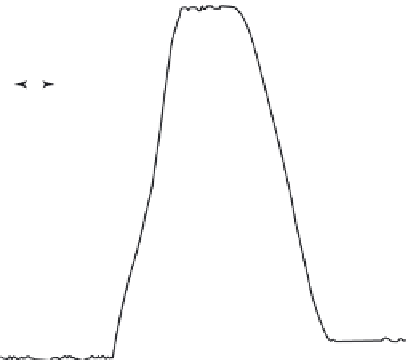Biomedical Engineering Reference
In-Depth Information
Cu, Zn-SOD
(ii)
1 nA
1 nA
2 s
4 s
xanthine
(i)
xanthine
xanthine
(a)
(b)
FIGURE 6.8
(a) Typical current-time response obtained at the Cu, Zn-SOD/cysteine-modifi ed Au
electrode in phosphate buffer (O
2
-saturated) solution containing 0.002 unit of XOD upon the addition of
50 nM xanthine and the subsequent addition of 6 µM Cu, Zn-SOD. (b) Current-time responses of (i) the
apo-SOD/cysteine-modifi ed Au electrode and (ii) the Cu, Zn-SOD/cysteine-modifi ed Au electrode toward
O
2
•
in phosphate buffer containing 0.002 unit of XOD upon the addition of 40 nM xanthine. The electrode
was polarized at
300 mV, and the solution was gently stirred with a magnetic stirrer at 200 rpm. (Reprinted
from [151], with permission from the American Chemical Society.)
Figure 6.8a shows the typical current-time response of the Cu, Zn-SOD/cysteine-
modifi ed Au electrode at
300 mV on addition of xanthine and Cu, Zn-SOD to the O
2
-
saturated phosphate buffer containing 0.002 U XOD. The introduction of 50 nM xanthine
into the solution produced a rapid and obvious increase in the anodic current. To verify
that the observed anodic current is attributed to the oxidation of O
2
•
rather than that
of the co-products of the XOD/xanthine-based O
2
•
generating reaction, i.e. uric acid
and H
2
O
2
, 6
M Cu, Zn-SOD was added into the solution since Cu, Zn-SOD, a selective
scanvenger of O
2
•
, can specifi cally dismutate O
2
•
. This addition caused the anodic cur-
rent to decrease by
µ
95% within 6 s (Fig. 6.8a). The addition of more Cu, Zn-SOD to
the solution resulted in the anodic current decreasing to almost the background current,
strongly indicating that only O
2
•
generated by the XOD-xanthine system is oxidized at
the Cu, Zn-SOD/cysteine-modifi ed Au electrode to give an amperometric response. In
order to examine the direct oxidation of O
2
•
at the Cu, Zn-SOD/cysteine-modifi ed Au
electrode without the above-mentioned redox mediation via Cu, Zn-SOD, the response
of the apo-SOD/cysteine-modifi ed Au electrode toward O
2
•
was also measured. The
apo-SOD (Cu-free derivative EZnSOD, E
empty) was prepared according to a method
described by Cocco and Calabrese [127]. As shown in Fig. 6.8b, much less response was

























Search WWH ::

Custom Search